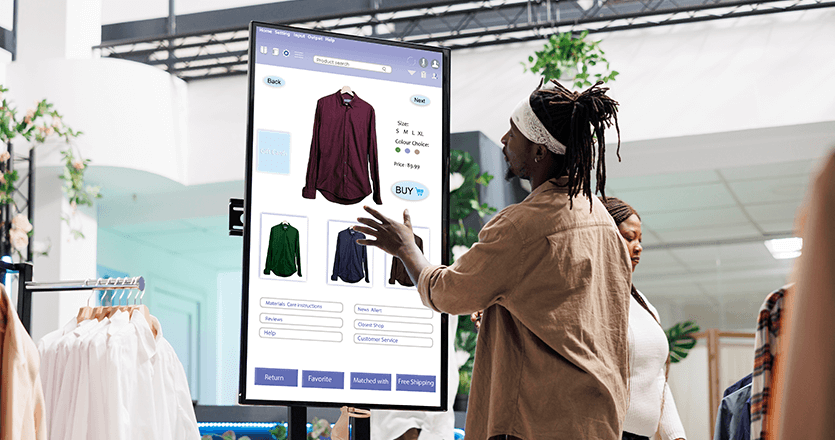We may not fully realize it, but the world we once watched in movies, brimming with screens and advanced technologies, is now the world we live in. It seems like only yesterday we were boasting to our friends about owning a computer or a cell phone. Now, everywhere we go, screens surround us, and we conduct our lives through them. From working and shopping to booking our trips and dining, we now rely on machines for almost everything.
As these technologies have evolved, interactivity has subtly integrated into almost every element of our daily lives. Once, we were amazed by the simple touch of a screen. Today, we engage in full conversations with voice-activated assistants, a testament to how profoundly our interaction with technology has transformed. Interactivity is no longer a mere feature but an expectation, and that fact is brought into particularly sharp focus when we look at the ways that brands must now connect with their audiences. It’s a powerful element that has transformed and enriched user experiences, making them more immersive and personal.
But what lies ahead? Let’s take a dive into the future of interactivity and uncover the possibilities it holds for businesses and individuals alike.
Augmented Reality (AR) and Virtual Reality (VR) beam up users into new digital worlds full of interactions
Augmented Reality (AR) and Virtual Reality (VR) are full of potential because they blend digital and physical so well. They give us the power to do things that were once thought of as far-off futuristic concepts. AR and VR represent the future of interactivity and stand at the cutting edge of the next wave of technology. We are on the brink of a new world of experiences where immersive realms of imagination will be enhanced by all our senses.
Augmented Reality (AR) digitally animates our real world, adding information and graphics to what we see all around us. Playful AR in the hands of a tech-savvy teenager can change already addictive Snapchat filters into hilarious masks and props. But when engineered for more serious purposes, AR goes well beyond simply enhancing the social media experience and makes it possible for companies to drive real change. For example, manufacturing organizations might use AR to address the soft skills deficit in a truly game-changing way. Holographic AR and machine learning can enhance the digitalization of the real world and drastically increase its interactivity. Consider the applications of AR in retail. Instead of spending days trying on and returning clothes, customers will be able to see how they look through AR holographs or even try on items virtually. The customer experience will be more fun and magical, leading to fewer returns and more satisfied customers.
Virtual Reality (VR), by contrast, dangles whole new worlds in front of us, conjured up out of seemingly nothing. Gaming has adopted it, making reality seem outdated. The real estate industry has likewise taken on a new allure for viewers who can work their way through the most distant homes without even having to stand up from their couches.
The approaches being used in AR and VR still have much more to teach us about new, nuanced routes for engagement with digital content – and the techniques involved will continue to evolve, with the opportunity for companies to reach their audiences in ways previously found only in sci-fi.
Artificial Intelligence (AI) is here to help us with user engagement
Why are we still debating the age-old question, “Will AI replace humans?” It seems obvious. What could be more intimate than an AI that mimics, behaves, and sounds like us? Yet, this very closeness increases our need to engage with our technological creations. AI algorithms provide highly personalized experiences, unlike anything we’ve seen before. Consider how Netflix or Spotify recommend movies or songs tailored to an individual’s preferences. Interaction with these predictive systems becomes a cycle of reinforced intimacy: the more you use them, the more they learn about you, ultimately serving your interests and pleasing you. This creates a sense of interpersonal reciprocity, binding us to the machine like an old friend.
When users ask chatbots and virtual assistants for help, they receive support and guidance, easing the frustration of feeling lost and unsure of what to do. On the other side of the screen, businesses are liberated from lengthy and costly processes in order to provide great experiences.
It is this unparalleled power to analyze past behavior, predict present needs, and offer contextualized suggestions that has brought about increased satisfaction and more engaged use of technology. Businesses can flourish with minimal effort when we embrace artificial intelligence as an ally and harness its advantages to improve user engagement.

IoT (Internet of Things) and interconnected experiences
Internet of Things (IoT) is a network of smart devices that communicate with each other, transforming how we interact with the world making everything more intuitive and connected.
From a house’s thermostat to its lights and security, all those remote controls and switches become part of the IoT, allowing homeowners to monitor and tweak settings from anywhere. These smart-home devices can learn users’ preferences and routines and then automate actions that make life more comfortable and efficient – such as automatically turning the thermostat down when the house is unoccupied or turning off lights when a room is empty.
IoT is also driving the automotive revolution with connected cars. By communicating with other devices, the connected vehicle will provide real-time traffic updates remote diagnostics and ultimately drive itself via autonomous-driving features. Connectivity will improve safety, convenience, and efficiency, ultimately enhancing each journey.
In healthcare, wearable fitness trackers and other remote monitoring systems connected to the IoT provide users with real-time health information. This data helps individuals make informed decisions about their health and fitness. While the technology isn’t yet capable of predicting disease outbreaks, it does allow for more adaptive patient care. Healthcare can become a continuous conversation rather than a one-off intervention, as real-time data offers insights that can lead to timely and personalized care.
IoT’s ability to allow gadgets to work together helps create more streamlined and intuitive experiences. The more devices communicate with each other, the more opportunities there will be for innovative and interactive applications.
What to consider?
Despite this enthusiasm for emerging interactive technologies to be widely harnessed, there are some challenges and considerations that need to be addressed.
- The implementation of such technologies as AR, VR, AI or IoT certainly requires investment. Businesses must weigh the costs and benefits of adopting such technologies to determine whether and to what extent they will integrate them into their operations.
- The greater the interactivity, the more ‘big data’ is generated. Earning the trust of users is about making sure their data is kept private and secured. Businesses need to build a fortress with formidable walls of tech-security and regulation.
- Ensuring that existing and new technologies can work together seamlessly is incredibly important to driving adoption and uptake. Businesses must keep compatibility with legacy systems in mind when implementing any new technology.
Overcoming these challenges will, therefore, be essential if the up-and-coming generations of interactive technologies are to be implanted.

What the future holds for digital signage interactivity
Imagine a bustling airport terminal equipped with interactive digital kiosks that provide real-time flight updates, assist with navigation, and offer personalized travel recommendations. These touchscreens enhance the travel experience by delivering timely information and interactive support, making the journey through the airport smoother and more engaging.
Imagine walking into any retail store and finding yourself confronted with AR-enabled digital signage overlaying digital content on top of the physical environment. This kind of augmented reality enables richly participatory experiences – say, additional product information appearing before your eyes or trying on clothes in front of a mirror that then reveals your body in new attire without you having to enter a fitting room. Shopping becomes an adventure of discovery.
As of today, this kind of technology is not yet a reality. But as the pace of technological advancement accelerates, so do our ideas about what the future of interactivity holds for us.
Right now, the future of digital signage is marked by interactivity and individuality. Emerging technologies are helping businesses craft an enriching and immersive digital signage experience, while also being remarkably personal and responsive.
How will the future unfold?
The next wave of interactivity will be much brighter as a new generation of technology promises to take our digital engagement to a new level. Using AR and VR, interactive systems can now transport us into entirely new worlds and engage users like never before. AI will train interactive systems to anticipate our needs and respond accordingly. IoT will allow us to interact with the Internet on a more natural and intimate level while offering a more seamless integration with our everyday lives.
These advancing technologies will create more opportunities and possibilities for businesses to engage with customers. In the world of digital signage, we can expect even more dynamic interactions through features like interactive kiosks, adaptable AR screens, and personalized digital content.
Yodeck’s digital signage solutions are at the forefront of this evolution, offering powerful tools to create engaging, real-time content that can adapt to individual preferences and needs. With Yodeck, businesses can harness these innovations to deliver immersive and impactful experiences, ensuring they remain at the cutting edge of digital signage technology. The future of interactivity is not just around the corner—it’s here and promises to be anything but boring.
